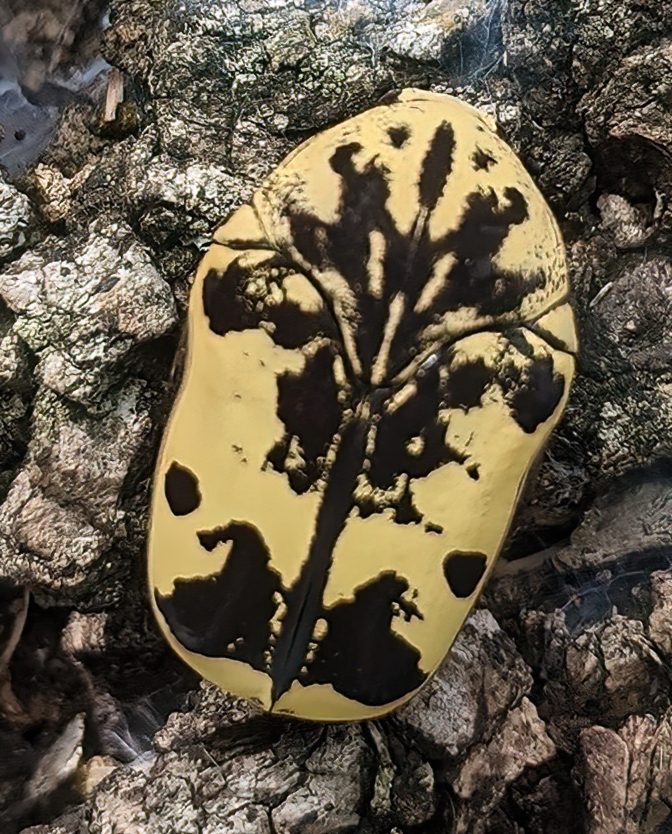The ornate creature in the soil-filled crotch of our ash tree appeared to be a decorated rock or a lost jewel, a pendant perhaps. Never had I seen such a thing—a beetle’s yellow carapace embossed with an ink rendering of an outspread tree, or maybe a Rorschach test.
Then I picked it up, noting its insect parts. When I took a photo and downloaded it to iNaturalist—a phone app which helps identify all sorts of wildlife—I discovered it was a Harlequin Flower Beetle (Gymnetis thula), a type of scarab beetle that occurs in states along the Gulf of Mexico, as well as eastern Mexico. Its genus name combines “gymn”, which means “naked or bare” and “ett” for small, while its species name “thula” means “the farthest north”.

These black and yellow beauties devour ripe fruit, sap and other plant liquids, and their larvae nourish themselves on decayed wood and plant matter. I wonder if the Harlequin Flower Beetle I spotted in our tree’s humus last September was a fresh adult that emerged from a cocoon it built near its feeding grounds.
Evidently, the Harlequin Flower Beetle, unlike many, is a robust flier, and it creates a bumblebee-like buzz while doing so, perhaps fooling a wary predator into thinking it a stinging bee. How predators—including birds, raccoons, lizards and snakes—perceive the Harlequin and other brightly-patterned beetles is a mystery, of course, but the creatures’ flashy colors might prove confusing to some. Predators might also be dissuaded by the foul-smelling fluid Harlequin Flower Beetles secrete or that the beetles appear to “play dead”, since many animals, instinctively fearing illness, harbor a natural revulsion to eating dead things.
The Harlequin Flower Beetle joins hundreds of thousands of other living creatures in the order Coleoptera—whose name springs from Greek “Koleos”, for sheath, and “pteron” for wings. Coleoptera, which includes all beetles, is the largest order of animals, one that encompasses a third of insects, with more beetles likely to be discovered. A fourth of known animals are beetles, and they inhabit all continents except Antarctica.
“Beetle” apparently comes from an old English word “bitela”, meaning “little biter”. Distinctive to beetles are their elytra, or shield-like forewings that cover and protect flight wings, which are tucked away underneath. When a beetle launches itself, its elytra swing out, helping stabilize the creature. Elytra also force air downwards, increasing lift. Here is a short PBS video which aptly demonstrates a Rhinoceros Beetle’s flight:
Most beetles do not fly far.
Also, beetles undergo complete metamorphosis—emerging from eggs as larvae—which undergo various instars, or stages—then transform into pupae and eventually adults. The larvae eat constantly.
The Harlequin Flower Beetle occupies the family Scarabaeidae, for scarab beetles—known for their stout, large heads and pronotums, or dorsal plates of their foremost thorax segments. Scarabs have lamellae, or clubbed antennae— leaflike plates they can draw into little balls or fan out to smell things. Their front tibiae, or leg sections, are wide and suitable for digging, and they have five-segmented tarsi, or final leg segments—which usually end in claws. Scarab beetle larvae are C-shaped and white or yellowish in color.

Many adult scarabs like the Harlequin Flower Beetle, being distinctively ornamental, are prized as pets. Scarabs are ubiquitous in Ancient Egyptian jewelry, hieroglyphics, art and mythology, including that of Khepri, a god that scooted the sun across the sky daily—rather like certain scarab beetles that roll dung in which to plant their eggs.
The Harlequin Flower Beetle, a good pollinator, poses no threat to us. It lives for about six months, during which it must remain hydrated, as desiccation can be fatal. It can also die from being unable to right itself after it falls on its back. This beetle requires textured surfaces to hold onto.
Since I spotted this wondrous creature in early September last year, I check my ash tree daily in hopes of seeing another. Here is an interesting and informative video presented by a breeder of Harlequin Flower Beetles:
I am constantly amazed by the fascinating creatures, large and small, that enrich our lives and imaginations in the Rio Grande Valley.